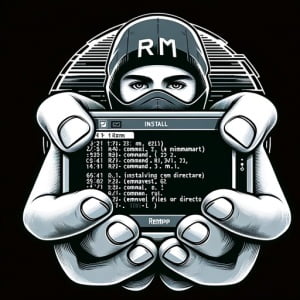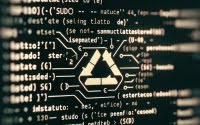Installing and Mastering the ‘rm’ Command in Linux

Are you trying to figure out how to delete files and directories in your Linux system? For many Linux users, especially beginners, the task might seem a bit daunting. However, the ‘rm’ command in Linux, akin to a digital paper shredder, is an essential tool that’s worth mastering. It’s available in most Linux distributions, making the process straightforward once you understand the steps.
In this guide, we will navigate you through the installation and usage of the ‘rm’ command in Linux. We will provide instructions for both APT-based distributions like Debian and Ubuntu, and YUM-based distributions like CentOS and AlmaLinux. We’ll also delve into advanced topics like compiling from source and installing a specific version of the ‘rm’ command. Finally, we will guide you on how to use the ‘rm’ command and ensure the correct version is installed.
So, let’s dive in and start mastering the ‘rm’ command in Linux!
TL;DR: How Do I Install the ‘rm’ Command in Linux?
The
'rm'command comes pre-installed in almost all Linux distributions, you can verify this with,rm --version. If, however, it is not installed, you can add it by installing, or reinstalling, the coreutils package,sudo apt-get install [--reinstall] coreutils, orsudo yum reinstall coreutils. To use it, you can simply type'rm'followed by the name of the file or directory you want to delete.
For example
rm example.txt
# Output:
# The file 'example.txt' is deleted.
This is just the basic usage of the ‘rm’ command in Linux, but there’s much more to learn about using ‘rm’ effectively and safely. Continue reading for more detailed information and advanced usage scenarios.
Table of Contents
- Understanding and Using the ‘rm’ Command
- Installing ‘rm’ Command from Source Code
- Installing Different Versions of ‘rm’ Command
- Understanding Different Versions of ‘rm’ Command
- Verifying ‘rm’ Command Installation
- Exploring Alternative Methods for File Deletion in Linux
- Troubleshooting the ‘rm’ Command in Linux
- File Management in Linux: The Foundation of ‘rm’ Command Usage
- The Relevance of File Management in System Administration and Security
- Wrapping Up: Installing the ‘rm’ Command in Linux
Understanding and Using the ‘rm’ Command
The ‘rm’ command in Linux is a powerful tool used for removing files and directories. It stands for ‘remove’ and is akin to the ‘delete’ function in other operating systems. This command is essential for managing files and maintaining a clean and efficient system. Let’s look at how to use the ‘rm’ command in Linux.
Installing ‘rm’ Command Using APT
On Debian-based Linux distributions like Ubuntu, we use the Advanced Package Tool (APT) to manage packages. Since the ‘rm’ command is a part of the coreutils package, it comes pre-installed. To ensure it’s installed, you can attempt to reinstall the coreutils package:
sudo apt-get install --reinstall coreutils
# Output:
# 'coreutils' is already the newest version (8.30-3ubuntu2).
This command will either reinstall the coreutils package or inform you that you already have the latest version installed.
Installing ‘rm’ Command Using YUM
For Red Hat-based Linux distributions like CentOS, we use the Yellowdog Updater, Modified (YUM) to manage packages. Similar to APT, the ‘rm’ command comes pre-installed as part of the coreutils package. To ensure it’s installed, you can use the following command:
sudo yum reinstall coreutils
# Output:
# Package coreutils-8.22-24.el7.x86_64 already installed and latest version
This command will either reinstall the coreutils package or inform you that you already have the latest version installed.
Using the ‘rm’ Command in Linux
Now that we’ve confirmed the ‘rm’ command is installed, let’s use it to delete a file. Suppose you have a file named ‘sample.txt’ that you want to delete. You can use the following command:
rm sample.txt
# Output:
# The file 'sample.txt' is deleted.
This command will delete the ‘sample.txt’ file from your current directory. Be careful when using the ‘rm’ command, as deleted files cannot be recovered.
Installing ‘rm’ Command from Source Code
For those who prefer more control over their installations, the ‘rm’ command can be installed from source code. This allows you to compile and install the specific version you want. Here’s how to do it:
wget http://ftp.gnu.org/gnu/coreutils/coreutils-8.32.tar.xz
# Output:
# 'coreutils-8.32.tar.xz' saved
# Extract the tarball
tar -xf coreutils-8.32.tar.xz
# Change to the directory
cd coreutils-8.32
# Configure the package
./configure
# Compile and install
make
sudo make install
This set of commands downloads the source code, extracts it, changes into the directory, configures the package, and finally compiles and installs it.
Installing Different Versions of ‘rm’ Command
There may be instances where you need to install a different version of the ‘rm’ command. This could be due to compatibility issues, specific features in a particular version, or testing purposes. Here’s how you can install different versions:
From Source
The process is similar to the one above. You just need to replace the version number in the wget command with the version number you want.
Using APT
sudo apt-get install coreutils=8.30-3ubuntu2
# Output:
# 'coreutils' is already the newest version (8.30-3ubuntu2).
Using YUM
sudo yum downgrade coreutils-8.22-24.el7.x86_64
# Output:
# Package coreutils-8.22-24.el7.x86_64 already installed and latest version
These commands will install a specific version of the ‘rm’ command using APT and YUM, respectively.
Understanding Different Versions of ‘rm’ Command
Different versions of the ‘rm’ command may have different features or compatibility. For example, newer versions may contain bug fixes or new features, while older versions may be required for compatibility with older scripts or systems.
| Version | Features | Compatibility |
|---|---|---|
| 8.32 | Latest features, bug fixes | Latest Linux distributions |
| 8.30 | Older features, fewer bug fixes | Older Linux distributions |
| 8.22 | Basic features, more bugs | Older scripts, systems |
Verifying ‘rm’ Command Installation
After installing the ‘rm’ command, you can verify its installation and check the version using the following command:
rm --version
# Output:
# 'rm' (GNU coreutils) 8.32
This command will display the version of the ‘rm’ command installed on your system.
Exploring Alternative Methods for File Deletion in Linux
While the ‘rm’ command is a powerful tool for managing files and directories in Linux, there are alternative methods that offer different advantages. Let’s explore some of these alternatives.
The ‘find’ Command
The ‘find’ command in Linux is a versatile tool that can locate files and directories based on various criteria such as name, size, or modification time. It can also execute commands on the files it finds, including the ‘rm’ command. Here’s an example of using the ‘find’ command to delete files:
find . -name "*.txt" -exec rm -f {} \;
# Output:
# All '.txt' files in the current directory and its subdirectories are deleted.
This command finds all ‘.txt’ files in the current directory and its subdirectories, and then deletes them using the ‘rm’ command.
GUI File Managers
Graphical User Interface (GUI) file managers provide a visual and intuitive way to manage files and directories. Examples include Nautilus in Ubuntu and Dolphin in KDE. To delete a file using a GUI file manager, you simply select the file and press the ‘Delete’ key.
While GUI file managers are easy to use, they may not be as efficient as command-line tools for complex tasks or large numbers of files.
| Method | Advantages | Disadvantages |
|---|---|---|
| ‘rm’ command | Powerful, efficient, can be automated | Can be dangerous if used incorrectly |
| ‘find’ command | Versatile, can locate files based on various criteria | More complex than ‘rm’ |
| GUI file managers | Easy to use, intuitive | Not as efficient as command-line tools for complex tasks |
In conclusion, while the ‘rm’ command is a powerful tool for file management in Linux, alternative methods like the ‘find’ command and GUI file managers offer different advantages and can be more suitable depending on the situation.
Troubleshooting the ‘rm’ Command in Linux
While the ‘rm’ command is a powerful tool, it’s not without its potential issues. Here are some common problems you might encounter when using the ‘rm’ command and how to solve them.
Permission Denied
If you try to delete a file or directory that you don’t have permission to delete, you’ll encounter a ‘Permission denied’ error.
rm protected_file.txt
# Output:
# rm: cannot remove 'protected_file.txt': Permission denied
To resolve this, you can use the ‘sudo’ command to run ‘rm’ as the root user:
sudo rm protected_file.txt
# Output:
# The file 'protected_file.txt' is deleted.
Directory Not Empty
If you try to delete a directory using the ‘rm’ command without the ‘-r’ (recursive) option, you’ll encounter a ‘Directory not empty’ error.
rm some_directory
# Output:
# rm: cannot remove 'some_directory': Is a directory
To resolve this, you can use the ‘-r’ option to delete the directory and its contents recursively:
rm -r some_directory
# Output:
# The directory 'some_directory' and its contents are deleted.
Protecting Important Files
The ‘rm’ command can be dangerous if used incorrectly, as it can delete important files irreversibly. To protect important files, you can set the ‘i’ (interactive) attribute using the ‘chattr’ command:
sudo chattr +i important_file.txt
# Output:
# The file 'important_file.txt' is now protected.
Now, if you try to delete this file using the ‘rm’ command, you’ll encounter an ‘Operation not permitted’ error:
rm important_file.txt
# Output:
# rm: cannot remove 'important_file.txt': Operation not permitted
To delete the file, you’ll need to remove the ‘i’ attribute first:
sudo chattr -i important_file.txt
rm important_file.txt
# Output:
# The file 'important_file.txt' is deleted.
These are just some of the issues you might encounter when using the ‘rm’ command in Linux. Always remember to use the ‘rm’ command carefully to avoid accidentally deleting important files.
File Management in Linux: The Foundation of ‘rm’ Command Usage
Understanding file management in Linux is crucial to mastering the ‘rm’ command. Linux, like all operating systems, uses files and directories to organize data. These files and directories are managed using various commands, one of which is the ‘rm’ command.
The Importance of File Management in Linux
File management is a fundamental aspect of any operating system, and Linux is no exception. Proper file management ensures that files and directories are organized in a way that makes it easy to locate and access them. It also involves managing file permissions to ensure that only authorized users can access certain files.
ls -l example.txt
# Output:
# -rw-r--r-- 1 user group 0 Jan 1 00:00 example.txt
In this code block, the ‘ls -l’ command is used to display the details of ‘example.txt’. The ‘-rw-r–r–‘ part shows the file permissions, ‘user’ shows the owner of the file, and ‘group’ shows the group that owns the file.
Related Commands to ‘rm’
There are several commands related to ‘rm’ that are also used for file management in Linux. These include:
- ‘ls’: Lists the contents of a directory.
- ‘cd’: Changes the current directory.
- ‘cp’: Copies files and directories.
- ‘mv’: Moves or renames files and directories.
- ‘mkdir’: Creates a new directory.
- ‘rmdir’: Removes an empty directory.
These commands, along with ‘rm’, provide a comprehensive set of tools for managing files and directories in Linux. By understanding these commands and how they relate to each other, you can better understand the role of the ‘rm’ command and how to use it effectively.
The Relevance of File Management in System Administration and Security
File management is not just about keeping your directories clean and organized. It plays a significant role in system administration and security in Linux systems. The ability to create, delete, and manage files effectively is a critical skill for any system administrator.
File Permissions and Ownership in Linux
In Linux, every file and directory has an associated set of permissions and an owner. These permissions control who can read, write, or execute the file. They are crucial for maintaining the security of a Linux system.
ls -l example.txt
# Output:
# -rw-r--r-- 1 user group 0 Jan 1 00:00 example.txt
In this code block, the ‘ls -l’ command is used to display the details of ‘example.txt’. The ‘-rw-r–r–‘ part shows the file permissions, ‘user’ shows the owner of the file, and ‘group’ shows the group that owns the file.
Understanding file permissions and ownership is crucial for using the ‘rm’ command safely and effectively. Deleting the wrong file or not having the correct permissions can lead to data loss or system instability.
Further Resources for Mastering File Management in Linux
If you’re interested in diving deeper into file management in Linux, here are some resources that can help:
- The Linux Command Line: A Complete Introduction by William Shotts: This book provides a comprehensive introduction to the Linux command line, including file management commands.
Linux File System Hierarchy from The Linux Documentation Project: This guide explains the structure of the Linux file system and the purpose of different directories.
File Permissions and Ownership by Ryan’s Tutorials: This tutorial provides a detailed explanation of file permissions and ownership in Linux, including how to change permissions and ownership using commands like ‘chmod’ and ‘chown’.
Wrapping Up: Installing the ‘rm’ Command in Linux
In this comprehensive guide, we’ve delved into the nuances of using the ‘rm’ command in Linux to manage files and directories effectively. We’ve covered everything from the basics to advanced use, providing a solid foundation for both beginners and intermediate users alike.
We started with the basics, explaining how to install and use the ‘rm’ command in Linux. We then explored more advanced topics, such as installing from source code, managing different versions, and understanding the implications of file permissions and ownership.
We also discussed how to troubleshoot common issues that might arise when using the ‘rm’ command, such as ‘Permission denied’ and ‘Directory not empty’ errors. We provided practical solutions and tips to solve these problems and ensure smooth operation.
We ventured into alternative methods for managing files in Linux, comparing the ‘rm’ command with other tools like the ‘find’ command and GUI file managers. Here’s a quick comparison of these methods:
| Method | Advantages | Disadvantages |
|---|---|---|
| ‘rm’ command | Powerful, efficient, can be automated | Can be dangerous if used incorrectly |
| ‘find’ command | Versatile, can locate files based on various criteria | More complex than ‘rm’ |
| GUI file managers | Easy to use, intuitive | Not as efficient as command-line tools for complex tasks |
Finally, we delved into the broader context of file management in Linux, discussing its relevance in system administration and security. We also provided resources for further exploration of this topic.
The ‘rm’ command is a fundamental tool for file management in Linux. Mastering it not only helps in maintaining a clean and efficient system but also equips you with the skills necessary for effective system administration. We hope this guide has empowered you to use the ‘rm’ command in Linux with confidence. Happy Linux-ing!


